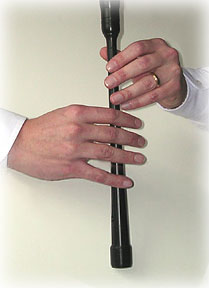The
Sound of the Pipes for All Occasions
 How to learn to play the bagpipes
How to learn to play the bagpipes
The best advice that I can offer you is to locate a good instructor
and take lessons for at least a year or two. Besides helping you avoid additional
frustrations with learning, the instructor can help you purchase your first
set of pipes and get set up with a pipe band. Where to
find a Piper provides you with direction on how to find a bagpipe instructor
in your area.
The key steps to learning to play the bagpipes include:
- Finding an instructor
- Obtaining a practice chanter
- Setting aside time to practice each day
- Buying a taperecorder to tape lessons & practices
One can always take the initiative to buy a "learn on your own" book, but you may find yourself breaking your chanter in half after a few weeks of frustration. Your first challenge is understanding how to place your fingers over the chanter's holes as illustrated in the picture
.

(Right image from BagpipeJourney.com's 'Bagpipe Finger Positions'. Copyright Andrew T. Lenz, Jr. Used with permission)
Instead, use the links on this site to locate someone in your area to get you started. After a few weeks of lessons on the practice chanter you will understand what I mean.
You should read Learning Bagpipes without an Instructor for some additional comments about learning the pipes.
Other
items include instruction books like Logan's Tutor or the College of Piping
Tutor books, Vol. 1, 2 & 3. Both are easy to read, but both require a
degree of interpretation by the novice.
The important piece of equipment is the practice chanter (shown above) . It
is used to learn the notes, fingering of the different embelishments, and the
tunes that you will play on the great highland bagpipe or Scottish smallpipes.
You can either buy one at a bagpipe supply store (or on eBay) or an instructor
may lend you one. The cost is around $75.00 for a good one.
The practice chanter provides a softer sound than the bagpipe chanter and is played by blowing into the mouthpiece. The breathe travels over a plastic reed and produces the sound.
Upon learning the scale of nine notes, some embellishments, and getting your fingers to cover the
holes properly, you are ready to learn some tunes.
To get started with a chanter, an instructor for a few lessons, and a tutoring
book will cost about $150.00. An option for newcomers is to sit in on a local
bagpipe band practice. Some bands offer free lessons to new members as a way
to encourage membership. It is worth the effort, especially if you are not certain
about your commitment to the task.
You can expect to invest a year or two on the practice chanter before buying your first set of bagpipes. Once you have your pipes you will take about another year getting used to them and blowing the reed and three drones. After five or more years you will have begun to master the pipes, and your pipes will begin to have a mellower tone to it. This sounds like a long time, but it goes by quickly if you enjoy it and work hard at it.
Good luck and good piping!
IIntro page
I How the bagpipe sounds I What
to look for I When to use a piper I Weddings
& Funerals I Learning the pipes I Where
to find a piperI
All rights reserved by Thomson Chew 2009
Please contact me via email at
Thomson C. Chew
Web Site Notes:
Last Update & Software used: August 12, 2009 Dreamweaver 8.0
Printing pages from this site requires setting your page margins to 0.25"
on all four sides to avoid layout changes on a 8.5"x 11" page with
"portrait" orientation.
Practice chanter tune called My Land from Jim McGillivray (all rights reserved)
Image of fingers on the chanter from Andrew Lenz's Bagpipe Journey